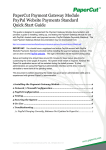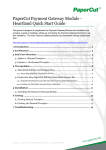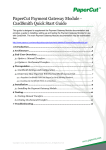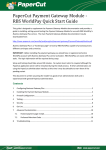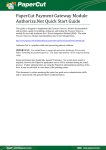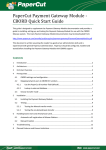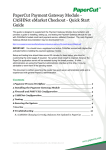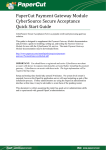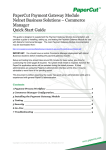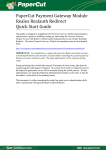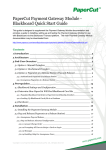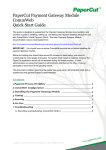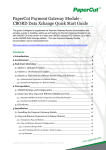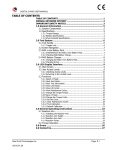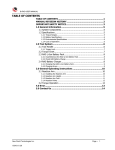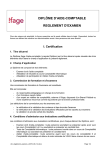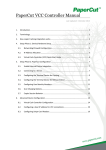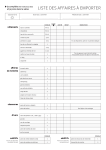Download Payment Gateway Module - PayPal Website Payments
Transcript
PaperCut Payment Gateway Module Official Payments Quick Start Guide This guide is designed to supplement the Payment Gateway Module documentation and provides a guide to installing, setting up, and testing the Payment Gateway Module for use with Official Payments’ hosted credit card payment service. The main Payment Gateway Module documentation may be downloaded from: http://www.papercut.com/anonftp/pub/pcng/ext/payment-gateway/PaymentGatewayModule.pdf IMPORTANT: You must register an active Official Payments product ID before installing the payment gateway module. This can be done by contacting Official Payments to request an ID for integration. Please see Section 3 Official Payments Configuration for more information. Setup and testing time should take around 30 minutes for basic setup, plus time for customizing the order pages if required. No system level restart is required; however the PaperCut application server will be restarted during the install process. If other administrators are using the PaperCut administration interface at this time, it may be advisable to warn them of the pending restart. This document is written assuming the reader has good server administration skills and is experienced with general PaperCut administration. 1 Installing the Payment Gateway Module..............................................2 2 Network / Firewall Configuration........................................................ 4 3 Official Payments Configuration.......................................................... 5 4 Testing.................................................................................................. 6 5 Securing the System..............................................................................7 6 Go-Live.................................................................................................. 7 7 Troubleshooting....................................................................................8 7.1 Payment made, Balances Not Updated in PaperCut........................................... 8 Copyright © 2011 PaperCut Software International Pty. Ltd., All Rights Reserved PaperCut - Payment Gateway Module - Official Payments - Quick Start Guide v2015-04-22 1 Installing the Payment Gateway Module 1. The Payment Gateway Module will function during the PaperCut NG 40 day trial period. After this, the module must be licensed. If you have been supplied with a new license take the time to install this now. The license install procedure is documented in the PaperCut user manual chapter ‘Licensing and Support’. 2. Download the Payment Gateway Module from the PaperCut website at http://www.papercut.com/anonftp/pub/pcng/ext/payment-gateway/pcng-paymentgateway-module.exe 3. Install the module into the same directory as PaperCut. This is normally: C:\Program Files\PaperCut NG\ 4. Open the file: [app-path]\server\lib-ext\ext-payment-gateway-officialpayments.properties in a text editor such as Notepad. 5. Locate the line officialpayments.enabled=N and change the N to Y. This will enable the Official Payments module. 6. Locate the line officialpayments.product-id and enter your Official Payments product ID. 7. Ensure that the officialpayments.postback-url option is set to a valid URL corresponding to the current deployment of PaperCut. This URL must be externally accessible by Official Payments and will be used to receive post back responses for any transactions that occur which are originated by the users of the current PaperCut deployment. The URL may use a port but in such case the port must be enabled by an authorized representative of Official Payments. If using an SSL (HTTPS) URL, the SSL certificate must be installed on the server used for Official Payments post backs. Important Security related considerations: OPC does not recommend using self-signed SSL certificates. All 3rd party signed certificates must support at least 128 bit encryption. OPC applications do not support wildcard SSL certificates e.g. https://*.clientwebsite.gov. Client will need to request individual certificates for each host and domain name that is required to secure. 8. Configure other options in this file as discussed in General Configuration Options in the Payment Gateway Module documentation, or by referring to the comments in the Copyright © 2011 PaperCut Software International Pty. Ltd., All Rights Reserved 2 PaperCut - Payment Gateway Module - Official Payments - Quick Start Guide v2015-04-22 file itself. Options include limits on the amount to transfer, access groups, custom error messages, and the messages displayed to users after a successful or failed transaction. You may like to enable a group restriction to limit access to administrators until configuration is complete. 9. Save the file and exit the text editor. 10. Restart the PaperCut Application Server service via Control Panel -> Administrative Tools -> Services and wait 30 seconds. 11. Check the end of the log file at [app-path]\server\logs\server.log for any obvious error messages. Copyright © 2011 PaperCut Software International Pty. Ltd., All Rights Reserved 3 PaperCut - Payment Gateway Module - Official Payments - Quick Start Guide v2015-04-22 2 Network / Firewall Configuration Official Payments server sends transaction notification messages to the PaperCut server via HTTP (only) on port 80 by default. Official Payments call this feature “post back”. You will need to ensure that Official Payments is able to contact the PaperCut server via an internet-accessible hostname on port 80/443 or in the case of a custom port by contacting the Official Payments integration representatives. Locally, this will usually involve the following network changes: 1. Set up a public DNS entry to ensure the PaperCut server is publicly accessible via a friendly name (e.g. papercut.myorg.edu). 2. Either: a. Allow internet access directly to the PaperCut server over port 80 (if running on Windows), or b. Set up external firewall rules to port forward from the public address on port 80 to the PaperCut server port 9191 or 9192. This is generally the preferred option on Linux, Mac or Novell. It is important that the firewall policy only applies to external hosts. Internal hosts will require direct access to the PaperCut server. During testing it may be appropriate to open access from any host then lock down access to the Official Payments server IP addresses later. Incoming messages from Official Payments will be sent from www.officialpayments.com. 3. Accessing the following URL with a web browser will display a simple confirmation page containing the current time, and can be used to test external access: http://papercut.myorg.edu/rpc/gateway/official-payments Copyright © 2011 PaperCut Software International Pty. Ltd., All Rights Reserved 4 PaperCut - Payment Gateway Module - Official Payments - Quick Start Guide v2015-04-22 3 Official Payments Configuration Official Payments configuration needs to be done through an authorized integration contact within Official Payments. The settings that are required for successful deployment include: - Issuing of a vendor/product ID to use Official Payments services. Enabling post back of XML based responses. Enabling post back on a custom port from within Official Payments servers (if custom port is used) Registering any certificates issued by a custom Certificate Authority within Official Payments servers - Copyright © 2011 PaperCut Software International Pty. Ltd., All Rights Reserved 5 PaperCut - Payment Gateway Module - Official Payments - Quick Start Guide v2015-04-22 4 Testing The payment gateway module is now ready for testing. This test will involve performing a live transaction with a test credit card, against a staging server provided by Official Payments. 1. Log into the PaperCut user web interface at http://papercut:9191/user 2. A new link called Add Credit should be present on the left. Click this link. 3. Select an amount to add and click Add Value. 4. You should now be redirected to Official Payments for payment. Enter the payment details including a valid credit card number and associated details as requested. 5. After entering payment details you should be presented with a success (or failure) page with a printable receipt link. At this stage the payment should have already taken place, and Official Payments has contacted PaperCut via the post back feature to report the transaction (causing PaperCut to add the value to the user’s account). There should also be a Return button. Click this to return to PaperCut. 6. You should now be back at the Add Credit page. You should see a green message indicating that the funds were added to your account, and Current Balance should show your new account balance. The Transaction History page should contain the payment transaction. Note: it is possible in times of network congestion or a communication failure that the post back has not yet been sent to PaperCut by the time the user returns to the Add Credit page. In this case an appropriate message will be displayed to the user, and their balance will be updated when the IPN arrives. See the Troubleshooting section for more information. Copyright © 2011 PaperCut Software International Pty. Ltd., All Rights Reserved 6 PaperCut - Payment Gateway Module - Official Payments - Quick Start Guide v2015-04-22 5 Securing the System Because Official Payments sends the transaction data to PaperCut directly (not along with the user), users are not provided with an opportunity to tamper with the order data. It is however possible for users who know the post back URL and the unique order Id to “spoof” a transaction if they know the right data and format. This risk can be mitigated by: 1. Restricting the post back URL so that it can only be called by Official Payments server IP addresses. See the postback-allowed-ip option in the config file. 2. Implementing a “shared secret”. This is a secret token/password that is known only to Official Payments and the PaperCut server, and never exposed to the user. PaperCut will then only accept post-back messages that contain the shared secret, so that a user can only forge post-back messages if they also know it. To implement the post-back shared secret: a. Find the officialpayments.shared-secret option in the config file and assign a random alphanumeric string that will serve as the secret/password. E.g. “officialpayments.shared-secret=1n2bxn5h” b. Update the post-back URL in the Official Payments server by contacting an Official Payments integration team representative. E.g. The post-back URL can be set as “https://papercut.myorg.edu/rpc/gateway/officialpayments/ 1n2bxn5h”. c. Post-back messages should now only be accepted if they contain the configured shared secret. If you like you can try entering the wrong shared secret in the URL to ensure that it is rejected while configured against a staging server (an error message will be logged to the App. Log). 6 Go-Live If end-user access was in place during testing, it can now be removed to allow access to end-users. Your system is now live and will accept and charge credit cards. Copyright © 2011 PaperCut Software International Pty. Ltd., All Rights Reserved 7 PaperCut - Payment Gateway Module - Official Payments - Quick Start Guide v2015-04-22 7 Troubleshooting Administrators may find information in the following log files useful when trying to troubleshoot setup/configuration problems or issues reported by end-users. Payment Gateway Event Log: [app-path]\server\logs\payment-gateway\event.log This log contains gateway specific error messages and events. Application Log: [app-path]\server\logs\server.log This log contains general application specific error messages and events. Transaction Log: [app-path]\server\logs\payment-gateway\transaction.log This log contains a list of successful transactions in a tab-delimited form. Please feel free to contact the PaperCut Software Development Team at [email protected] if you require assistance. 1.1 Payment made, Balances Not Updated in PaperCut If Official Payments is charging cards/accounts correctly but no balances are being updated in PaperCut, there is most likely a problem with the post-back messages getting through. 1. In the Official Payments interface, navigate to Payment Verification . 2. Enter the email address of the user and any of the ancillary information required to identify the transaction. 3. If the transaction is listed as processed, check the payment gateway event log file (location above) for error messages. If there are no obvious messages you can reproduce the problem with debug logging enabled to see more information about the messages sent and received. Copyright © 2011 PaperCut Software International Pty. Ltd., All Rights Reserved 8








